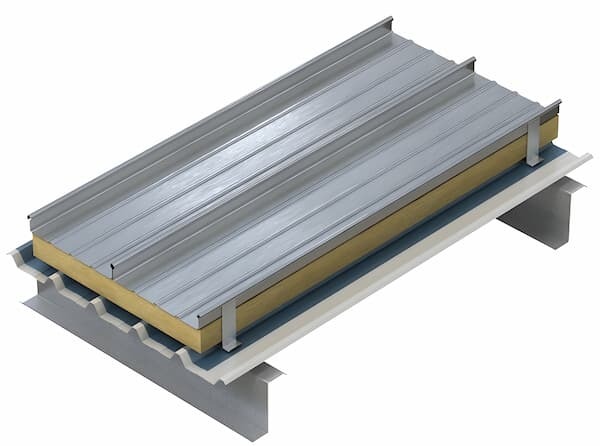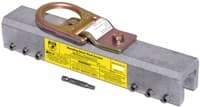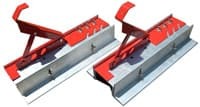Fall Protection Solutions for Kingspan Standing Seam Panels
Posted by Howie Scarboro - CEO Fall Protection Distributors, LLC on Oct 30th 2025
See the Roof Anchor Compatibility Chart for Kingspan Standing Seam Panels.

Who Is Kingspan?
Kingspan combines innovation, sustainability, and high-performance roofing expertise to lead the global insulated metal panel industry.
Kingspan Group has redefined energy-efficient metal roofing since its founding in 1965. Established by Eugene Murtagh in Kingscourt, Ireland, the company began as Kingscourt Construction, focusing on structural steel and framed buildings. From those early days, Kingspan's philosophy centered on performance, precision, and long-term value.
During the 1970s, Kingspan expanded its vision by entering the insulated panel market. This move marked the beginning of a global transformation. Through the 1980s and 1990s, the company built advanced manufacturing facilities across Ireland and the United Kingdom, eventually setting its sights on North America. By 2000, Kingspan had launched Access Flooring operations in both the UK and the USA, establishing itself as a dominant force in insulated metal roofing and wall systems.
Today, Kingspan operates more than 210 manufacturing facilities in over 80 countries, employing more than 22,000 people worldwide. Its reputation for high-performance, energy-efficient building materials continues to set industry standards. The company's insulated metal roofing systems, like the KingSeam, combine superior thermal performance, fire protection, and design flexibility. The KingSeam panel, for instance, captures the architectural beauty of traditional standing seam roofs while offering the modern advantages of factory-insulated metal construction.
Kingspan's dedication to sustainability goes beyond marketing. In 2019, it reached Net Zero Energy across all global operations. It introduced its Planet Passionate program to drive even greater environmental responsibility. That same year, Kingspan opened IKON, its global innovation center in Ireland, focused on developing technologies that improve building performance and reduce carbon impact. Kingspan's continued commitment to innovation and sustainability positions it among the most forward-thinking companies in modern construction.

What Is The Most Compatible Fall Protection For Kingspan Standing Seam Roofs?
Non-penetrating anchors protect Kingspan roof systems, preserve warranties, and maintain complete OSHA and ANSI compliance for every jobsite.
Kingspan's standing seam roofing systems are known for strength, precision, and energy efficiency. Their concealed clip assemblies allow the panels to expand and contract with temperature changes, maintaining watertight integrity and long-term durability. Because of this floating design, fall protection systems must not penetrate or distort the seams. Drilling through panels or clips would compromise both the roof's performance and its warranty.
The safest and most compatible approach is to use non-penetrating seam-mounted anchors that clamp securely to the seam without creating holes or leaks. By pairing Kingspan's advanced standing seam panels with SSRA non-penetrating anchors, Super Anchor lifeline kits, and Ridge Pro safety systems, contractors maintain roof integrity, protect warranties, and meet the highest safety standards on every Kingspan project.
KingSeam IMP Mechanical Panels

KingSeam panels combine a classic standing-seam style with advanced insulation, energy efficiency, and long-term performance for modern metal roofing projects.
The KingSeam insulated standing seam roof system by Kingspan delivers the traditional appearance of metal roofing with the advanced performance of modern insulated panel technology. It provides exceptional thermal efficiency, durability, and a clean architectural look that appeals to both designers and building owners. See the Roof Anchor Compatibility Chart for Kingspan KingSeam IMP Mechanical Standing Seam Panels.
Each KingSeam panel incorporates CFC-free polyisocyanurate insulation, achieving R-values ranging from 12 to 46, depending on thickness. This high thermal performance reduces energy costs and helps maintain consistent indoor temperatures year-round. The panels are 22-, 24-, or 26-gauge steel and feature a strong trapezoidal rib design that enhances strength and resists damage from foot traffic, making them ideal for high-traffic rooftop areas.
Installation is efficient and straightforward. KingSeam panels come in standard 40-inch widths and lengths from 8 to 50 feet, allowing for quick coverage and lower labor costs. The mechanically seamed joint forms a tight, weather-resistant lock that protects against wind uplift and water intrusion, even on low-slope roofs. These panels can be installed directly over open purlins or solid decking without underlayment, offering flexibility and speed during construction.
Kingspan's attention to detail extends to airtightness and weather resistance. The KingSeam system undergoes rigorous testing to ensure it maintains air and water tightness throughout the life of the building, preventing unwanted heat loss or air leakage. The panels are Galvalume® or are factory-applied with durable paint coatings. They are available with non-embossed, stucco, or mesa textures for architectural versatility. Panel thickness options include 3.25", 4", 5", and 6", allowing designers to balance insulation performance with structural requirements.
Fall Protection for KingSeam Panels
Non-penetrating SSRA systems and the Ridge Pro Steep Assist provide safe, roof-friendly solutions for all KingSeam steel gauges and slopes.
The SSRA product line is fully compatible with 22- and 24-gauge steel KingSeam panels, offering safe, non-penetrating anchorage options that protect workers and the roof system.
The SSRA1 Standing Seam Roof Anchor attaches directly to KingSeam panel seams using stainless steel set screws that grip securely without puncturing the metal surface. This design maintains the roof's watertight integrity while providing a 5,000-pound-certified tie-off point for single-worker protection.
For projects requiring walkboards, the SSRA2 Adjustable Roof Jack Adapter mounts on top of the SSRA1 anchors. It supports 10-foot walkboards without roof penetrations and adjusts to match various seam heights and roof pitches, creating a stable walking platform for work on steep sections.
When maximum worker mobility is required, the SSRA3 Anchor Plates pair with the Malta Dynamics HLL3001 Horizontal Lifeline System to form the SSRA HLL 100-Foot Temporary Horizontal Lifeline Kit. This system provides a secure tie-off for two workers while allowing them to move across wide roof spans without disconnecting. The Super Anchor 120-foot Permanent Horizontal Lifeline kit is another great option for jobs that require long-term protection.
For 26-gauge KingSeam panels or roofs with pitches between 6:12 and 12:12, the Ridge Pro Steep Assist Anchor offers a reliable tie-off point that does not rely on the strength of the seam. It hooks over the ladder using a 16-foot extension pole, keeping workers entirely tied off before they step onto the roof. Because it does not clamp to the panel seams, it is an ideal solution for thinner-gauge metal panels.
By combining SSRA non-penetrating anchors, lifeline kits, and Ridge Pro systems, contractors can maintain OSHA and ANSI compliance while protecting Kingspan's high-performance roof design. These tools allow safe, efficient work on KingSeam panels without compromising the roof's strength, appearance, or long-term warranty.
KingZip Panels


KingZip panels deliver unmatched design flexibility, enabling architects to create curved, tapered, and complex standing-seam roofs without sacrificing strength or efficiency.
The KingZip standing seam panel system from Kingspan represents one of the most versatile roofing solutions available today. It gives architects and builders the freedom to design intricate roof shapes while maintaining the superior performance expected from Kingspan products. This combination of strength, flexibility, and aesthetic appeal makes KingZip a popular choice for modern architectural projects where visual impact and durability must work hand in hand. See the Roof Anchor Compatibility Chart for Kingspan KingZip Standing Seam Panels.
KingZip panels are available in 12-inch and 16-inch widths, with aluminum and steel base metals. They can be factory-rolled up to 50 feet or site-rolled up to 500 feet, giving contractors the flexibility to meet unique project dimensions. The panels' adaptability allows for continuous sheet runs from ridge to eave, minimizing joints and reducing the potential for leaks.
One of the defining advantages of KingZip is its suitability for curved applications. When produced in 0.9 mm aluminum, the panels can be curved to a 16-foot convex radius or a 26-foot concave radius, enabling seamless transitions on even the most complex roof designs. These panels work exceptionally well on buildings that feature sweeping contours or dynamic rooflines. However, curved roof installations require professional oversight. A qualified fall protection specialist should inspect and plan each site to ensure all safety measures meet OSHA and ANSI standards before work begins.
KingZip panels perform reliably on roofs with pitches of ½:12 or greater. Their standing seam design enhances weather resistance, allowing for thermal expansion while maintaining airtight and watertight performance. Kingspan's advanced materials and coatings also improve energy efficiency, helping to reduce overall heating and cooling costs. Acoustic and fire performance are additional strengths of the KingZip system, offering quiet interiors and strong resistance to fire spread—critical factors for commercial, institutional, and industrial structures.
Fall Protection for KingZip Panels
SSRA and Ridge Pro systems deliver safe, non-penetrating fall protection for non-curved steel KingZip roofs, while curved systems require professional evaluation.
Maintaining worker safety on KingZip panels begins with choosing compatible, non-penetrating fall protection systems that preserve the roof's structural integrity. The SSRA product line works perfectly with non-curved 22- and 24-gauge steel KingZip panels. In contrast, curved panels require alternate solutions determined by a trained safety professional due to material softness and differences in seam design.
The SSRA1 Standing Seam Roof Anchor clamps directly to steel KingZip seams without drilling, maintaining watertight performance while providing a 5,000-pound-certified tie-off point for fall arrest.
For walkboard applications, the SSRA2 Adjustable Roof Jack Adapter mounts on top of the SSRA1 anchors. It supports 10-foot wooden walkboards and adjusts to various seam heights, providing crews with a safe, level working surface for extended tasks.
When workers need horizontal mobility, the SSRA3 Anchor Plates pair with the Malta Dynamics HLL3001 Horizontal Lifeline System to form the SSRA HLL 100-Foot Temporary Horizontal Lifeline Kit. This configuration supports up to two workers, allowing movement across long roof spans while maintaining 100% tie-off compliance. For jobs requiring long-term protection, the Super Anchor 120-foot Permanent Horizontal Lifeline kit is a great non-penetrating option.
For aluminum KingZip panels with 6:12 and 12:12 pitches, the Ridge Pro Steep Assist Anchor provides a fast, secure solution. It hooks over the ridge from the ladder using a 16-foot extension pole, giving workers tie-off access before stepping onto the roof. This setup ensures total protection on steep or elevated surfaces without causing roof damage.
Curved KingZip roofs present unique challenges that require specialized safety planning. Before starting work, a qualified safety professional should evaluate the roof before determining the best fall protection products and techniques to prescribe.
By following these safety practices and using SSRA and Ridge Pro systems where compatible, contractors can complete KingZip panel installations safely while maintaining Kingspan's roof performance, warranty protection, and architectural quality.
Standing Seam Metal Roof Anchor Panel Compatibility For Kingspan Steel Panels
| KingSeam IMP 24 Ga. | KingSeam IMP 22 Ga. | KingZip 24 Ga. | KingZip 22 Ga. | |
|---|---|---|---|---|
SSRA 1 |
NO | YES | NO | YES |
SSRA1 Nylon Tip |
YES | YES | YES | YES |
SSRA2 Roof Jack |
YES | YES | YES | YES |
SSRA3 Anchor Plate |
YES | YES | YES | YES |
The Ridge Pro |
YES | YES | YES | YES |
Contact Us With Your Standing Seam Fall Protection Questions
For further details on roofing solutions and fall protection systems, contact us at 863-703-4522 or www.StandingSeamRoofAnchor.com. Let's work together to make your roofing projects safe, beautiful, and built to last. For more safety tips, refer to OSHA's 48-page Fall Protection Manual. Once you have determined the most suitable anchors for your roof system, download our free Anchor Inspection Form.
Safety Tips For Standing Seam Roofs
Develop OSHA Compliant Safety Plans
Every safe project begins long before anyone steps on the roof. A written plan defines tie-off locations, outlines rescue procedures, and identifies who will take charge in an emergency. When the entire crew understands the plan, response times improve, and everyone knows their role. Review the safety plan often, keep it current, and treat it as a working tool, not a formality. Preparation doesn't just meet OSHA requirements—it builds confidence and saves lives.
Use Specialized Anchor Systems for Standing Seam Roofs
Standing seam roofs require non-penetrating fall protection anchors. Non-penetrating systems, such as seam clamps, preserve the watertight floating design while providing OSHA- and ANSI-compliant tie-off points. This method keeps warranties intact and stops leaks before they start. Never rely on anchors that must line up with hidden clips; guessing their location under existing roof panels is nearly impossible.
Prioritize Ladder Safety Training
Ladder safety is the first defense against workplace injuries. Check every ladder before use, set it on firm, level ground, and follow the four-to-one rule for proper angle. Always keep three points of contact and avoid carrying tools while climbing. These habits may seem simple, but they prevent most falls that cause worker injuries. Ongoing training keeps workers sharp and aware, even on busy days.
Install Permanent Roof Anchor Systems
When roofs need regular maintenance, permanent anchors become the smartest investment a building owner can make. Once installed, they provide immediate, reliable tie-off points for service crews and inspectors without the need for setup or adjustment. They eliminate guesswork, improve efficiency, and ensure they are ready for the next visit. A well-placed permanent anchor transforms roof access from risky to routine.
Ensure Proper Footwear for Stability
Stable footing is the foundation of safety. Roofing boots with deep tread and solid ankle support help workers stay balanced on slick or uneven panels. The proper footwear minimizes fatigue, prevents rolled ankles, and improves control when moving materials. Most slips never happen when your boots grip like they should—choose shoes designed for metal roofs.
Encourage the Use of Trauma Straps
A fall arrest doesn't end when the worker stops falling. Suspension trauma can set in quickly when blood flow is restricted. Trauma straps let a suspended worker stand in their harness, relieve pressure, and maintain circulation until rescue arrives. They're small, inexpensive, and essential. Every harness should come equipped with them without exception.
Set Up Protective Guardrail Barriers for Work Zones
Guardrails work quietly in the background, but they prevent more accidents than most people realize. They protect crews near skylights, open edges, and roof perimeters while defining safe zones that keep movement organized. When workers know where the limits are, they can focus entirely on the task at hand rather than watch their footing. Guardrails are a simple solution that pays off every day.
Equip Workers with High Quality Safety Gear
The best fall protection plan is only as strong as the gear behind it. Harnesses that fit right, lanyards that lock securely, and lifelines that move smoothly all build trust between workers and their equipment. OSHA's updated 2025 standard now requires every piece of PPE to be appropriately sized for the individual wearing it. Quality gear doesn't just meet code, it builds confidence and saves lives.
Consult Experts for Curved Metal Panels
Curved standing seam roofs elevate architecture but complicate safety. Their seam geometry and radius require specialized equipment that won't distort or crush the panels. Before starting work, have a fall protection expert evaluate the roof's shape and recommend the proper anchors or lifeline systems. Professional assessment ensures the correct setup, protects the structure, and keeps workers safe from start to finish.
Promote a Culture of Safety
Real safety isn't a rule—it's a mindset. Crews that talk openly about hazards, share lessons, and look out for one another create safer job sites and stronger teams. Short safety meetings at the start of every shift keep awareness sharp. When everyone commits to the same goal, safety stops being a checklist and becomes part of the company's culture.
Disclaimer
The views, recommendations, and information presented in this blog are solely those of the author and do not necessarily reflect the opinions or positions of the featured panel manufacturer, its brands, subsidiaries, or parent companies. Customers are strongly encouraged to contact the roof panel manufacturer directly for inquiries regarding fall protection compatibility with their products and to address any potential warranty issues that may arise after installing our products.

